Experiment
Stories from the Afterlife Trial Workshop
“Well if it’s in landfill in 10 years’ time, how’s it going to get out of landfill? What do they do? Do they just stay there?”
“Sometimes I’ll have these thoughts, even when I’m throwing garbage out in a plastic bag, but then I sort of erase it from my mind. But I guess when we’re sitting here talking about it … ”
— Participant statements from Trial Workshop #1Aim
To trial a participatory design workshop as a method for generating stories of time with and in consumers (as participants). This workshop design uses interaction-based activities, requiring participants to engage with the materiality of the plastic to form stories about their past and future lives. It aims to facilitate a process of exploration and story generation amongst participants. This seeks to shift participant perspectives to consider the wider and nonhuman timelines that plastic operates at, and to visualise the longevity of plastic waste.
To test the effectiveness of this workshop design, two trial workshops were conducted. These are referred to as Trial Workshop #1 and Trial Workshop #2.
To test the effectiveness of this workshop design, two trial workshops were conducted. These are referred to as Trial Workshop #1 and Trial Workshop #2.
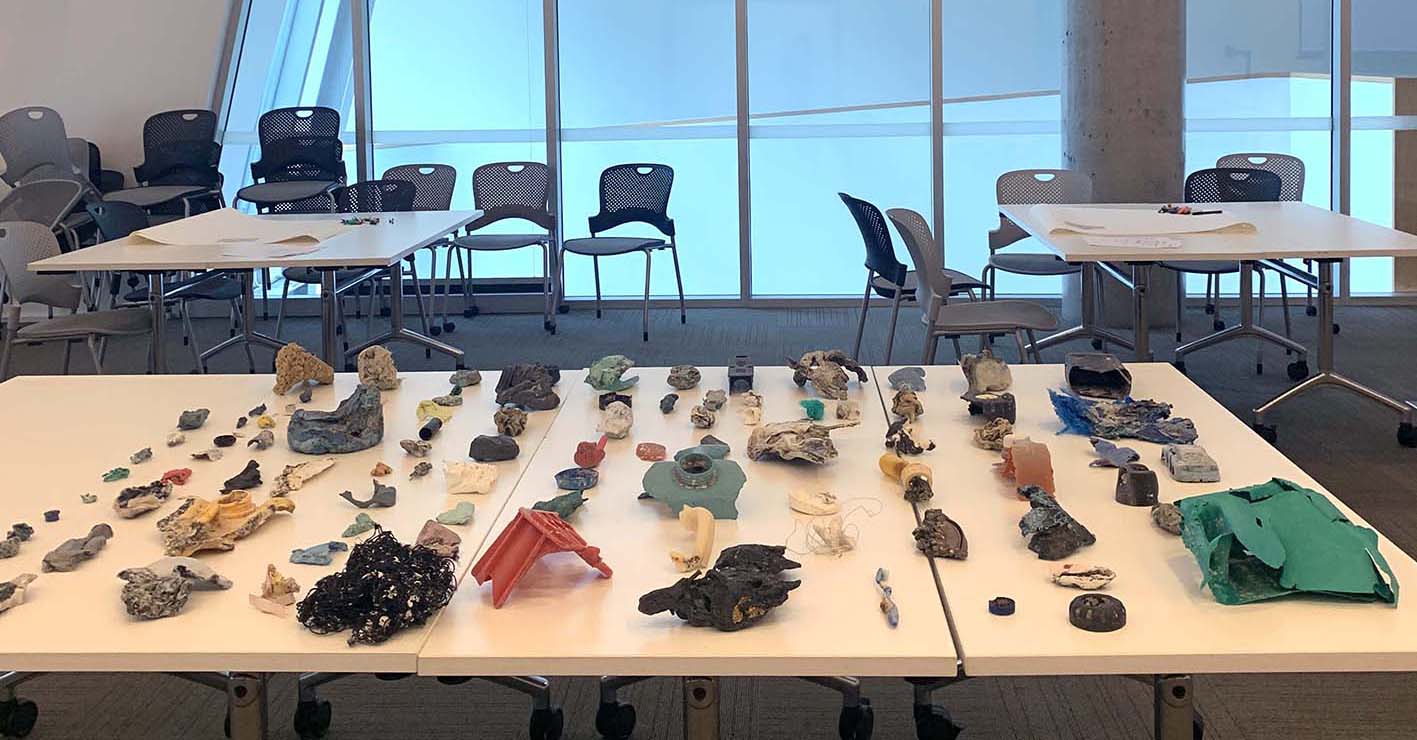

Precedents
This experiment addresses concerns from Experiment: Creative probe that relying on participants to move themselves through the tasks and document their own progress is risky as it depends on the individual motivations of each participant. Using Norris, Karana and Nimkulrat’s ‘Conversing WITH Materials’ (2018) and the Wertheims’ Crochet Coral Reef (2015) as a precedent, it proposes instead the situated context of a participatory design workshop as a solution.
![FIGURE 54 Elements taken from previous experiments.]() It uses the form of participatory design workshops to test the hypothesis generated in the conclusion of Approach Three—that it is the exploratory process of generating stories about plastic which can powerfully impact on understandings of the disposable nature of plastic. The design of this workshop translates the thinking brought out by previous experiments into the form of its activities and prompts (Figure 54). It takes from Approach One: Photographic Stories activities of visual observation of the plastic to shift participants outside of consumer perceptions of plastic waste. It takes from Approach Three: Speculative Stories acts of speculation about the past and future lives of plastic, which introduce nonhuman worldviews to participants as a way of accessing realisations of the nonhuman timelines that plastic operates in. In doing so, it also tests whether the specific processes I have created in these experiments are effective in facilitating conversation about the longevity of plastic in participants, and whether this changes their relationship to plastic in any way.
It uses the form of participatory design workshops to test the hypothesis generated in the conclusion of Approach Three—that it is the exploratory process of generating stories about plastic which can powerfully impact on understandings of the disposable nature of plastic. The design of this workshop translates the thinking brought out by previous experiments into the form of its activities and prompts (Figure 54). It takes from Approach One: Photographic Stories activities of visual observation of the plastic to shift participants outside of consumer perceptions of plastic waste. It takes from Approach Three: Speculative Stories acts of speculation about the past and future lives of plastic, which introduce nonhuman worldviews to participants as a way of accessing realisations of the nonhuman timelines that plastic operates in. In doing so, it also tests whether the specific processes I have created in these experiments are effective in facilitating conversation about the longevity of plastic in participants, and whether this changes their relationship to plastic in any way.
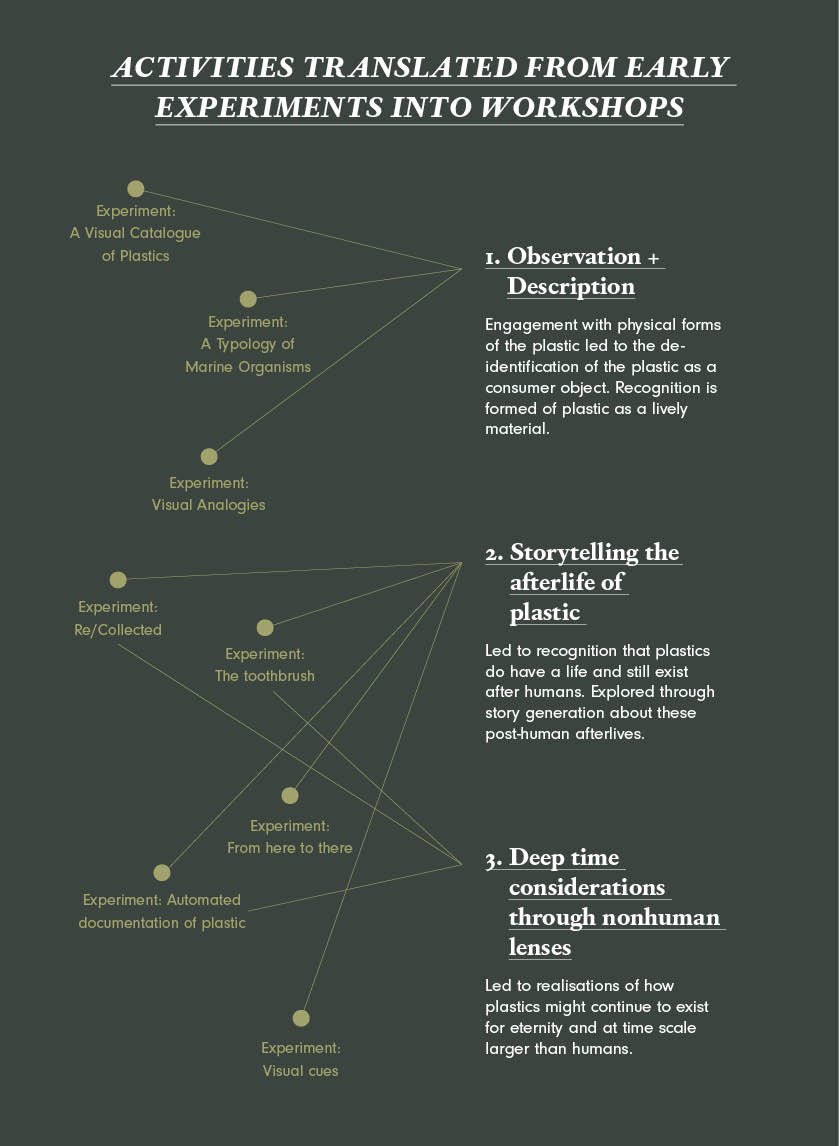
Workshop prompts

The structure of this workshop was made up of the facilitation of prompts to participants within the workshop (Figure 55), and a reflective follow-up survey 2 weeks after their participation.
These prompts intended to encourage participants to discuss and think through two key concepts; the longevity of plastic (through explorations of the past lives and warping of the plastic), and realisations of the deep and nonhuman timescales of plastic (through future speculations of time).

Participants
Participants for these trial workshops were recruited using personal networks. Trial Workshop #1 involved two participants from the fields of mathematics (a professional) and medical science (a student). I was particularly interested in recruiting these participants as their disciplinary backgrounds were so different from my own perspective as a designer. I was curious to see whether they would be open to a more creative and conceptual approach to changemaking outside of empirical methods, or whether they would be sceptical. Entering this workshop, then, there was a pre-conceived hypothesis that the content and design of the workshop would be more effective for certain types of participants than for others. The deciding factor for this would most likely be disciplinary training, or how their worldviews have been constructed.
Trial Workshop #2 had five participants present; from visual communication (professionals), megatronic engineering (a student), freshwater ecology (a student) and interior architecture (a professional). To begin to widen the participant pool to those outside of my own relationship circles, I had encouraged friends to invite their own friends and partners to participate in this workshop, resulting in a mix of participants who I had a pre-existing relationship with and those who I was meeting for the first time in a workshop setting. This resulted in a deliberate mix of empirical and creative mindsets amongst the participants, and I wanted to observe whether these pairings of participants would affect the outcomes and events of the workshop.
Given the larger numbers of Trial Workshop #2, participants were divided into two groups—Group #1 had three participants and Group #2 had two.
The choice of recruiting close friends as participants did, of course, pose limitations and potential bias in the results as they may have unintentionally swayed their responses in order to meet my expectations. However, a comfortable and supportive test environment was needed for practise and this outweighed the limitations.
Trial Workshop #2 had five participants present; from visual communication (professionals), megatronic engineering (a student), freshwater ecology (a student) and interior architecture (a professional). To begin to widen the participant pool to those outside of my own relationship circles, I had encouraged friends to invite their own friends and partners to participate in this workshop, resulting in a mix of participants who I had a pre-existing relationship with and those who I was meeting for the first time in a workshop setting. This resulted in a deliberate mix of empirical and creative mindsets amongst the participants, and I wanted to observe whether these pairings of participants would affect the outcomes and events of the workshop.
Given the larger numbers of Trial Workshop #2, participants were divided into two groups—Group #1 had three participants and Group #2 had two.
The choice of recruiting close friends as participants did, of course, pose limitations and potential bias in the results as they may have unintentionally swayed their responses in order to meet my expectations. However, a comfortable and supportive test environment was needed for practise and this outweighed the limitations.
Methods
This workshop used methods of storytelling to constructing stories about time and custodianship, and had a collaborative workshop structure. Brainstorming was used in its prompt design to facilitate shifts in thought toward the nonhuman longevity of plastic in participants.
Storytelling
Drawing off Stoknes’ arguments that “the more we tell these stories, the more we will begin to live with them” (2015, p. 135), storytelling was used as a key method to facilitate concerns around plastic into the realities and ways of being of participants. In particular, it considered Colebrook’s question—“how might we read or perceive other timelines, other points of view and other rhythms?” (2013, p. 60)—in the intention behind its design.
This was enacted through the design of the workshop itself, which used activities to prompt participants to create stories through the perspective of plastic, as opposed to exploring participant perceptions of plastic. This was mostly achieved through anthropomorphic and analogous storytelling prompts, which asked participants to adopt the experiences of the warped plastics. In doing so, story generation de-centred and shifted “the eye from the body” (Colebrook, 2013, p. 55), creating a reality which recognised and was more ecologically aware of what lies outside of human-centred mindsets.
Explorations of time
Story generation prompts around the past and future deep time of plastic served to further de-centre human realities and encourage speculation about the wider effects of our consumption. This served to bring to light participants’ own mortality compared to that of the nonhuman and plastic, and make them recognise the other timelines in existence in this nonhuman world. This builds on Colebrook’s writings, which state that speculation involves “ranging beyond the present at the cost of its own life” (2013, p. 54).
Custodianship
Participants were asked to choose one plastic out of the 98 on display. This act of choosing had two purposes; to encourage exploration of all the plastics on display and to provide an opportunity for connections to form between participants and the plastic. Participants were given hypothetical custodianship of their chosen plastic and asked in later prompts to do with the plastic what they wished. Crafting the future of their chosen plastic through lenses of custodianship generated dialogue about the longevity of plastic and the wider effects of personal disposal actions.
Collaboration and conversation
The structure of the workshops was collaborative in nature and grouped participants together. This was done both for the comfort of participants and to facilitate discussion amongst participants themselves—thereby exposing participants to differing ideas and perspectives so that they can learn or be challenged by their partners. Similar to ‘Conversing WITH Materials’ (Norris et al., 2018) and Crochet Coral Reef (Wertheim & Wertheim, 2015), conversation was used to encourage a receptiveness and learning in participants.
This workshop assumed that each participant would interpret both the plastic and the workshop prompts in different ways. These served as ‘boundary objects’ (Star & Griesemer, 1989), where the desired outcome was not an enforcement of my own understandings of reality, but a merging or collaboration of the participants’ different perspectives in a way that encouraged further thought and potential motivation in participants. As such, it almost did not matter what the results of these workshops were, only that they sparked a conversation.
Brainstorming activities
Much like the way the experiments in this research were a brainstorm on how to approach the plastics, brainstorming activities—rapid idea generation in the form of mind mapping—were used in this workshop to encourage participants to consider an array of ideas and ways of looking at plastics outside of how they normally would. This was enacted to discourage the development of one single concrete response which may not have challenged participants to see outside human realities. Prompts which asked participants to brainstorm a ‘most likely’ and ‘most ridiculous’ scenario also worked to achieve this. Combined, these sought to “create a safe forum for the expression and free association of creative ideas, and quell any inhibitions of the participants by providing a judgement-free zone to explore new concepts” (Martin & Hanington, 2012, p. 22). This would generate a level of comfort for the participants, and in turn increase receptiveness and involvement in the workshops.
Storytelling
Drawing off Stoknes’ arguments that “the more we tell these stories, the more we will begin to live with them” (2015, p. 135), storytelling was used as a key method to facilitate concerns around plastic into the realities and ways of being of participants. In particular, it considered Colebrook’s question—“how might we read or perceive other timelines, other points of view and other rhythms?” (2013, p. 60)—in the intention behind its design.
This was enacted through the design of the workshop itself, which used activities to prompt participants to create stories through the perspective of plastic, as opposed to exploring participant perceptions of plastic. This was mostly achieved through anthropomorphic and analogous storytelling prompts, which asked participants to adopt the experiences of the warped plastics. In doing so, story generation de-centred and shifted “the eye from the body” (Colebrook, 2013, p. 55), creating a reality which recognised and was more ecologically aware of what lies outside of human-centred mindsets.
Explorations of time
Story generation prompts around the past and future deep time of plastic served to further de-centre human realities and encourage speculation about the wider effects of our consumption. This served to bring to light participants’ own mortality compared to that of the nonhuman and plastic, and make them recognise the other timelines in existence in this nonhuman world. This builds on Colebrook’s writings, which state that speculation involves “ranging beyond the present at the cost of its own life” (2013, p. 54).
Custodianship
Participants were asked to choose one plastic out of the 98 on display. This act of choosing had two purposes; to encourage exploration of all the plastics on display and to provide an opportunity for connections to form between participants and the plastic. Participants were given hypothetical custodianship of their chosen plastic and asked in later prompts to do with the plastic what they wished. Crafting the future of their chosen plastic through lenses of custodianship generated dialogue about the longevity of plastic and the wider effects of personal disposal actions.
Collaboration and conversation
The structure of the workshops was collaborative in nature and grouped participants together. This was done both for the comfort of participants and to facilitate discussion amongst participants themselves—thereby exposing participants to differing ideas and perspectives so that they can learn or be challenged by their partners. Similar to ‘Conversing WITH Materials’ (Norris et al., 2018) and Crochet Coral Reef (Wertheim & Wertheim, 2015), conversation was used to encourage a receptiveness and learning in participants.
This workshop assumed that each participant would interpret both the plastic and the workshop prompts in different ways. These served as ‘boundary objects’ (Star & Griesemer, 1989), where the desired outcome was not an enforcement of my own understandings of reality, but a merging or collaboration of the participants’ different perspectives in a way that encouraged further thought and potential motivation in participants. As such, it almost did not matter what the results of these workshops were, only that they sparked a conversation.
Brainstorming activities
Much like the way the experiments in this research were a brainstorm on how to approach the plastics, brainstorming activities—rapid idea generation in the form of mind mapping—were used in this workshop to encourage participants to consider an array of ideas and ways of looking at plastics outside of how they normally would. This was enacted to discourage the development of one single concrete response which may not have challenged participants to see outside human realities. Prompts which asked participants to brainstorm a ‘most likely’ and ‘most ridiculous’ scenario also worked to achieve this. Combined, these sought to “create a safe forum for the expression and free association of creative ideas, and quell any inhibitions of the participants by providing a judgement-free zone to explore new concepts” (Martin & Hanington, 2012, p. 22). This would generate a level of comfort for the participants, and in turn increase receptiveness and involvement in the workshops.
Data collection methods
To document the events of the workshop, and to gain insight into their effectiveness, the following forms of data were collected:
![FIGURE 57 Participant brainstorms from Trial Workshop #1.]()
![FIGURE 58 Participant brainstorms from Trial Workshop #2 Group #1.]()
![FIGURE 59 Participant brainstorms from Trial Workshop #2 Group #2.]()
![FIGURE 60 Participant observation notes from Trial Workshop #1.]()
![FIGURE 61 Participant observation notes from Trial Workshop #1.]()
![FIGURE 62 Textual analysis of workshop transcript.]()
- Collaborative participant brainstorms from each participant group; Trial Workshop #1 and Groups #1 and #2 from Trial Workshop #2. These were the mind maps conducted on butcher’s paper (Figures 57-59).
- Observational notes of participant behaviours. I took these while the participants worked to document any behaviours of note. The particular behaviours I was observing were pre-determined before the workshop (Figure 60 & 61).
- Audio recordings of workshop proceedings. Each group was audio recorded, and these were transcribed after the workshop (Figure 62).
- Follow-up survey responses

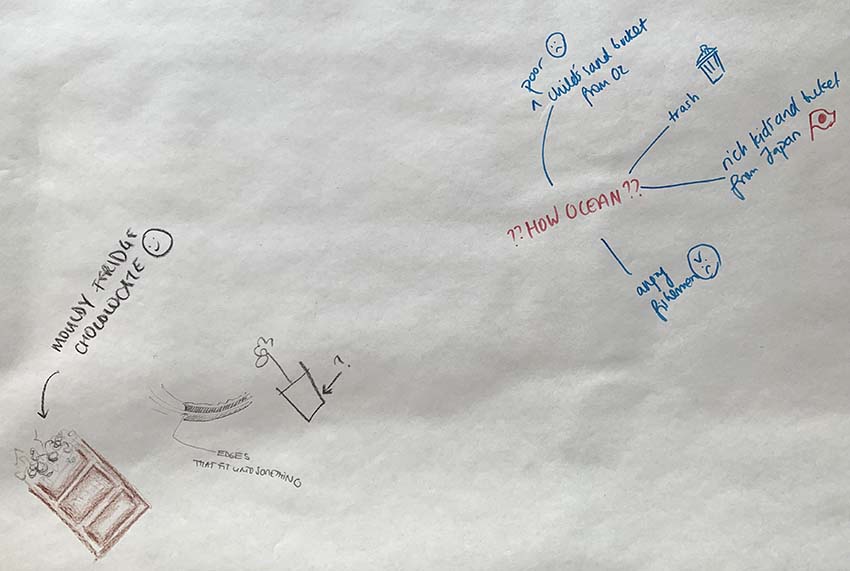
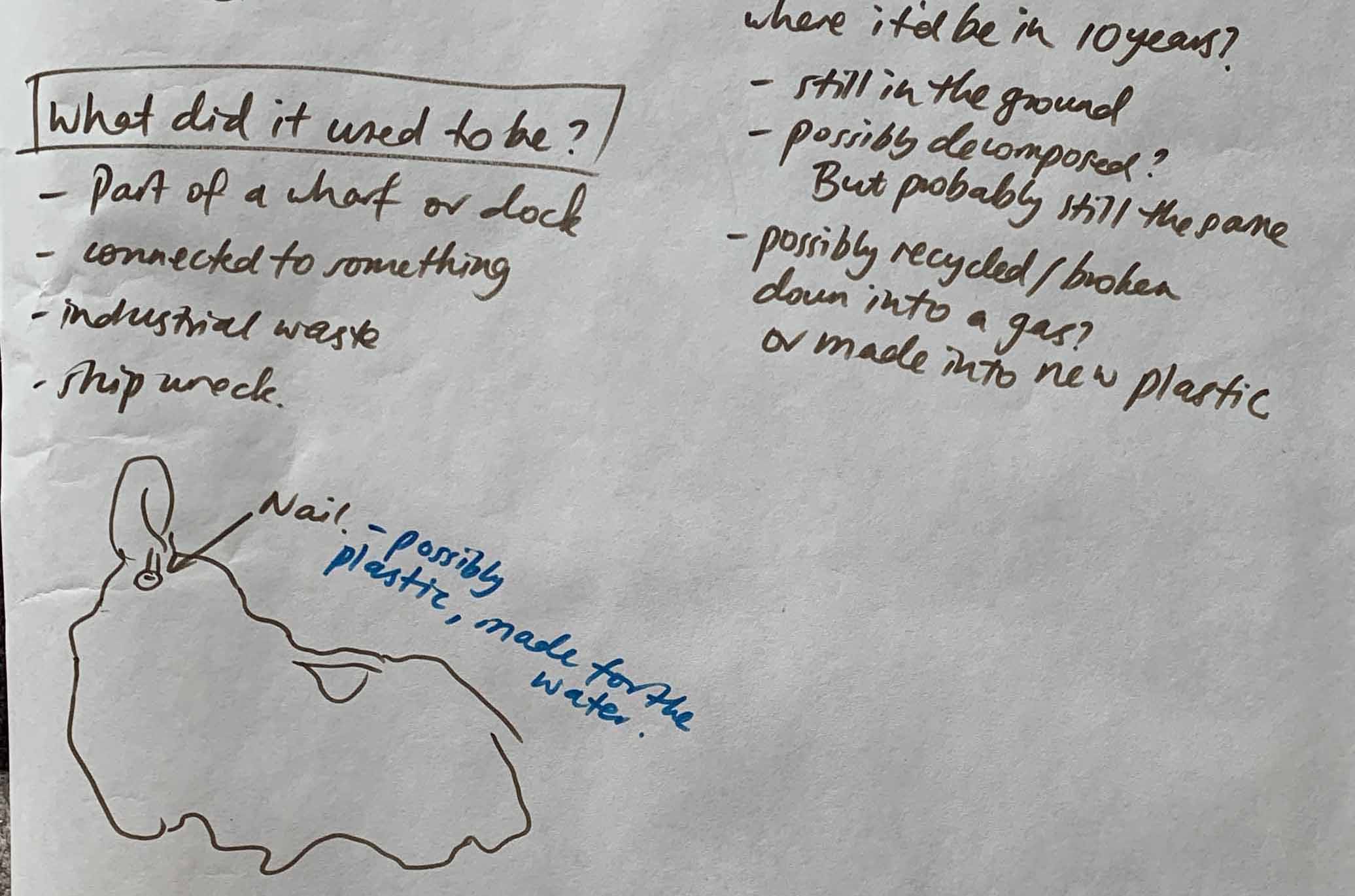
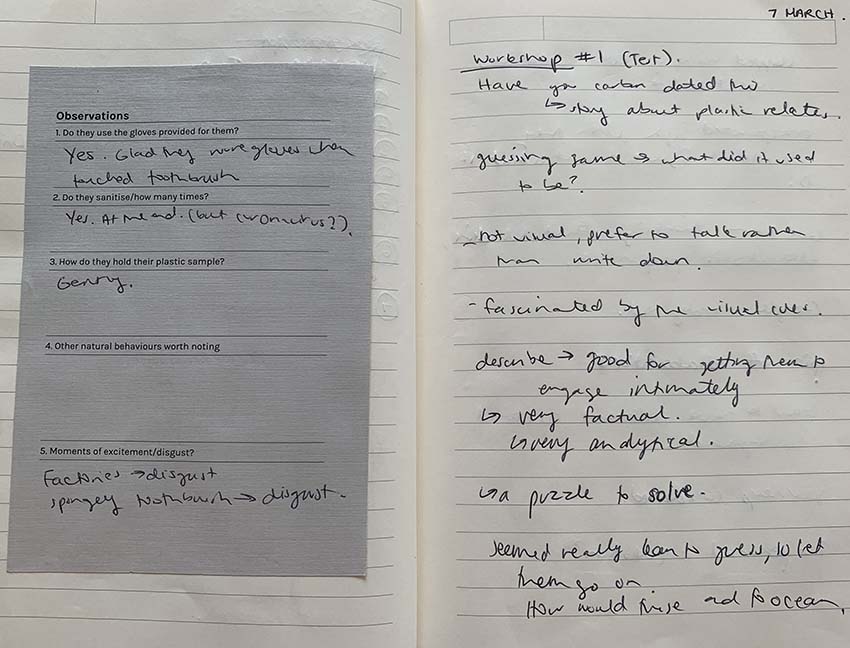

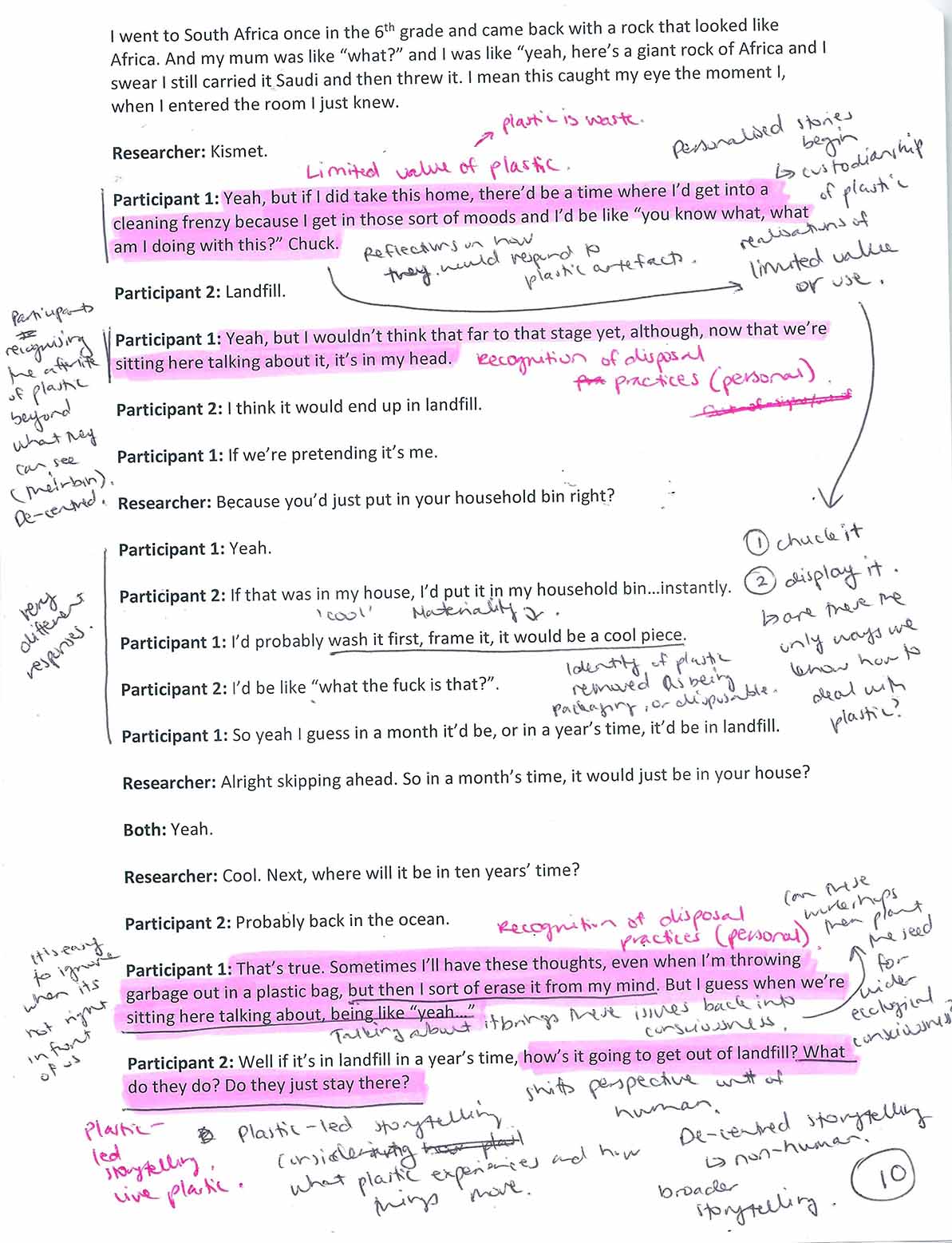
Methods of analysis
In order to gain insight from the data collected, reflective journaling—or Schön’s practice of reflection-on-action (1983)—was once again conducted. This involved reflecting upon and interpreting the observatory notes, the audio recordings of the workshops (transcribed into text) and the responses to the follow-up surveys. This method of reflective analysis was informed by a content analysis of the data, and—given the heavily text-based forms of the data collected—by a textual analysis of the collected material (Figure 84).
Results
Trial Workshop #1
Participants were particularly drawn to the idea of figuring out what exactly their plastic was, and how it came to be in the form that they saw it in. While this certainly did generate conversation and interest amongst participants, the later storytelling prompts were what brought out nonhuman and ecological discussion amongst participants.
![FIGURE 63 Visualisation of future stories generated by Trial Workshop #1 participants.]() Figure 63 demonstrates how it was storytelling at the 10-year mark that began to shift participants from human-centred worldviews to seeing from the perspective of their plastic artefact. This came about as a result of their unpacking of how exactly their plastic might move between spaces in time:
Figure 63 demonstrates how it was storytelling at the 10-year mark that began to shift participants from human-centred worldviews to seeing from the perspective of their plastic artefact. This came about as a result of their unpacking of how exactly their plastic might move between spaces in time:
“Well if it’s in landfill in 10 years’ time, how’s it going to get out of landfill? What do they do? Do they just stay there?”
— Participant statement
Participants thus began to generate stories through the ‘perspective’ of their specific plastic. Their stories shifted to consider how plastic behaves/exists/persists once in landfill. Effectively de-centred as humans, this ultimately led to the sad realisation that plastic would continue to be present in landfill:
“So if it’s in landfill, it would still be in landfill….”
“Sadly, yeah.”
— Participant statements
Their decision to ultimately dispose of their plastic if given custodianship of it brought forth ecological reflections in participants, with one participant’s remark that it would be “chucked into landfill” being met with:
“Yeah, but I wouldn’t think that far to that stage yet, although, now that we’re sitting here talking about it, it’s in my head.”
“Sometimes I’ll have these thoughts, even when I’m throwing garbage out in a plastic bag, but then I sort of erase it from my mind. But I guess when we’re sitting here talking about it, being like ‘yeah….’” — Participant statements
These reflections demonstrate how thoughts about where waste goes after it is thrown into household bins are often difficult to think about. These responses suggest an inadvertently subconscious regard of household bins as the last place waste goes before it goes ‘away’. It takes more effort on the part of the participant to not only bring these thoughts to the forefront, but to want to bring them to the forefront. The context of this workshop and the nature of the discussions therefore provided a space for this participant to reflect on and recognise their disposal practices.
The collaborative nature of the discussion—particularly the responses of participants to each other’s comments—also illustrated how the situated context of the workshop facilitated ideas and thoughts through conversation. The fact that it was one participant’s comments which drove ecological realisations in another supports this.
Trial Workshop #2
While the preliminary prompts of observation and description facilitated exploration and engagement with the plastics, it was once again the later prompts which proved effective in shifting participants of Trial Workshop #2 towards nonhuman thought.
![FIGURE 64 Visualisation of the future speculations of participants from Trial Workshop #2.]() Group #1’s responses were largely human-centred, even as prompts of time progressed to periods outside of their own lifespans (Figure 64). While their responses took on more fictional scenarios at 100 years to include futures where their plastic was in outer space, the participant who suggested these futures was clearly still operating within human-centred worldviews, stating that:
Group #1’s responses were largely human-centred, even as prompts of time progressed to periods outside of their own lifespans (Figure 64). While their responses took on more fictional scenarios at 100 years to include futures where their plastic was in outer space, the participant who suggested these futures was clearly still operating within human-centred worldviews, stating that:
“I’ll put it in a projector and I don’t know, just launch it out into space, get some other aliens to deal with it.”
— Participant statement
This demonstrated an absence of human de-centring as they still considered themselves to be the main factor influencing where their plastic would be in the future—despite the time period being 100 years in the future, and therefore a point in time where the participant may not be alive. While this perspective was expanded upon to move from an individual perspective to a more general perspective of humanity 1,000 years in the future, the majority of the responses at this point still considered humans as the main contributing actors to their plastic’s future.
Group #2, in comparison, began to shift to nonhuman perspectives after the 1-year mark, in considering how nonhuman actants such as tree roots may interact with their plastic and transform it (Figure 64). They continued to shift between human-centred and wider nonhuman perspectives, with scenarios such as—"we could venture to a volcano and just chuck it in there” being more human-centred—and other scenarios considering how plastic transforms when reacting to nonhuman elements such as heat and water being of a more nonhuman ontology. The results of this workshop therefore demonstrated a mix of nonhuman and human-centred considerations in the participants.
Similar to Trial Workshop #1, all participants in this workshop also chose to discard their plastic after a short period of time:
“Well, I don’t think there’d be much we could do with this.” — Participant statement
“This is not recognisable as plastic anymore. Like it wouldn’t be recycled.” — — Participant statement
This further reiterates how little value plastic had in the minds of participants, particularly when plastic was perceived as an ambiguous material (due to the warping) rather than as a functional object. This did, however, lead participants to acknowledge the problems of disposing—in that there was no alternative other than to dispose—through statements that it was “wishful thinking” otherwise, and that the reality of landfill was “sad”.
Present during this workshop was also an exasperation at the continual persistence of plastic. This exasperation was directed towards being confronted by these realities without an easy and disposable solution. This was demonstrated through participant statements of:
“We don’t need to do anything with it, and not feel guilty about it. Let nature do its thing.”
It was also evidenced in the collectively groaned “oh no” when the prompt asking participants to discuss the 100-year future of their plastic was given. The reluctance and dread towards this question revealed how difficult it was to consider and want to consider beyond the immediacy of human daily life. This highlights how difficult it is to look outside the human, as it relies on “ranging beyond the present at the cost of its own life” (Colebrook, 2013, p. 54). It is no wonder that considering the next 100 years prompted unpleasant reactions in participants, as it began to de-centre them too far from their human realities and called their own mortalities into consciousness.
Participants were particularly drawn to the idea of figuring out what exactly their plastic was, and how it came to be in the form that they saw it in. While this certainly did generate conversation and interest amongst participants, the later storytelling prompts were what brought out nonhuman and ecological discussion amongst participants.

“Well if it’s in landfill in 10 years’ time, how’s it going to get out of landfill? What do they do? Do they just stay there?”
— Participant statement
Participants thus began to generate stories through the ‘perspective’ of their specific plastic. Their stories shifted to consider how plastic behaves/exists/persists once in landfill. Effectively de-centred as humans, this ultimately led to the sad realisation that plastic would continue to be present in landfill:
“So if it’s in landfill, it would still be in landfill….”
“Sadly, yeah.”
— Participant statements
Their decision to ultimately dispose of their plastic if given custodianship of it brought forth ecological reflections in participants, with one participant’s remark that it would be “chucked into landfill” being met with:
“Yeah, but I wouldn’t think that far to that stage yet, although, now that we’re sitting here talking about it, it’s in my head.”
“Sometimes I’ll have these thoughts, even when I’m throwing garbage out in a plastic bag, but then I sort of erase it from my mind. But I guess when we’re sitting here talking about it, being like ‘yeah….’” — Participant statements
These reflections demonstrate how thoughts about where waste goes after it is thrown into household bins are often difficult to think about. These responses suggest an inadvertently subconscious regard of household bins as the last place waste goes before it goes ‘away’. It takes more effort on the part of the participant to not only bring these thoughts to the forefront, but to want to bring them to the forefront. The context of this workshop and the nature of the discussions therefore provided a space for this participant to reflect on and recognise their disposal practices.
The collaborative nature of the discussion—particularly the responses of participants to each other’s comments—also illustrated how the situated context of the workshop facilitated ideas and thoughts through conversation. The fact that it was one participant’s comments which drove ecological realisations in another supports this.
Trial Workshop #2
While the preliminary prompts of observation and description facilitated exploration and engagement with the plastics, it was once again the later prompts which proved effective in shifting participants of Trial Workshop #2 towards nonhuman thought.

“I’ll put it in a projector and I don’t know, just launch it out into space, get some other aliens to deal with it.”
— Participant statement
This demonstrated an absence of human de-centring as they still considered themselves to be the main factor influencing where their plastic would be in the future—despite the time period being 100 years in the future, and therefore a point in time where the participant may not be alive. While this perspective was expanded upon to move from an individual perspective to a more general perspective of humanity 1,000 years in the future, the majority of the responses at this point still considered humans as the main contributing actors to their plastic’s future.
Group #2, in comparison, began to shift to nonhuman perspectives after the 1-year mark, in considering how nonhuman actants such as tree roots may interact with their plastic and transform it (Figure 64). They continued to shift between human-centred and wider nonhuman perspectives, with scenarios such as—"we could venture to a volcano and just chuck it in there” being more human-centred—and other scenarios considering how plastic transforms when reacting to nonhuman elements such as heat and water being of a more nonhuman ontology. The results of this workshop therefore demonstrated a mix of nonhuman and human-centred considerations in the participants.
Similar to Trial Workshop #1, all participants in this workshop also chose to discard their plastic after a short period of time:
“Well, I don’t think there’d be much we could do with this.” — Participant statement
“This is not recognisable as plastic anymore. Like it wouldn’t be recycled.” — — Participant statement
This further reiterates how little value plastic had in the minds of participants, particularly when plastic was perceived as an ambiguous material (due to the warping) rather than as a functional object. This did, however, lead participants to acknowledge the problems of disposing—in that there was no alternative other than to dispose—through statements that it was “wishful thinking” otherwise, and that the reality of landfill was “sad”.
Present during this workshop was also an exasperation at the continual persistence of plastic. This exasperation was directed towards being confronted by these realities without an easy and disposable solution. This was demonstrated through participant statements of:
“We don’t need to do anything with it, and not feel guilty about it. Let nature do its thing.”
It was also evidenced in the collectively groaned “oh no” when the prompt asking participants to discuss the 100-year future of their plastic was given. The reluctance and dread towards this question revealed how difficult it was to consider and want to consider beyond the immediacy of human daily life. This highlights how difficult it is to look outside the human, as it relies on “ranging beyond the present at the cost of its own life” (Colebrook, 2013, p. 54). It is no wonder that considering the next 100 years prompted unpleasant reactions in participants, as it began to de-centre them too far from their human realities and called their own mortalities into consciousness.
Follow-up
survey
responses
survey
responses

The answers to the follow-up surveys highlight two distinct responses in participants (Figure 65). In half of the responses, participants stated that thinking about the future timeline of their plastic was what impacted them the most from the workshop. They wrote that thinking about deep time futures—and the persisting nature of their plastic within these futures—led to new perspectives, and signified a de-centring of them as humans. The other half of the responses stated that thinking through the past lives and journeys of their plastic was what impacted participants and made them consider the longevity of plastic. This highlights the success of storytelling and lenses of time in visualising the longevity of plastic for participants.
These responses also revealed that participants experienced changes in the way they thought about plastic as a result of the workshop. Some participants developed stronger ecological consideration for the products they purchased in everyday life—and consideration of alternatives—while other participants expressed that they began to think about the afterlife and longevity of plastic waste more often. It was thus thinking about nonhuman scales of time—either deep future time, or past lives—that triggered deeper reflections about the impacts of plastic in participants and how they used plastic in their personal lives. This demonstrates two different overall results of the workshops; an increased motivation to act in participants, and an increased motivation to think.
While the results from this survey highlight that thinking about the longevity of plastic motivated ecological thought/action in participants, it is likely that those who responded to this survey were the ones who were affected by the workshop, and who viewed its processes positively.
Reflection
There was an expectation that participants would use the butcher’s paper provided to plan their responses. I realised in hindsight that this is a designerly way of working and was not a natural process for participants from other disciplines. These participants preferred instead to discuss verbally rather than write down their responses. I did find, however, that having the butcher’s paper present made them stick to the prompts and not meander in conversation. As such, providing a medium for participants to record their thoughts and responses will be kept in the workshop design.
These participants did end up embracing the workshop, and I found that having them working together in groups assisted their responses. If one participant was more talkative than another, this also helped the quieter participant become more engaged and active within the workshop. The collaborative storytelling design of this workshop is hence effective. This collaborative structure also helped to facilitate conversation between participants, and allowed them to articulate their own concerns and thoughts about plastic disposal.
Prompt 6 (Figure 55), however, posed a problem in its wording—it was too specific in terms of referring to myself as the actor in the situation and confused participants. This needed to be reframed.
Overall, the responses to the follow-up survey demonstrate this experiment’s success in using stories of time to facilitate ecological thought. The familiarity between myself and the participants, and the security that this brought, however, is a factor to consider in terms of the eagerness of participants in the workshops. More workshops will need to be conducted to expand outside of my immediate circles, and confirm whether this workshop design can be repeated across more varied participant demographics.
These participants did end up embracing the workshop, and I found that having them working together in groups assisted their responses. If one participant was more talkative than another, this also helped the quieter participant become more engaged and active within the workshop. The collaborative storytelling design of this workshop is hence effective. This collaborative structure also helped to facilitate conversation between participants, and allowed them to articulate their own concerns and thoughts about plastic disposal.
Prompt 6 (Figure 55), however, posed a problem in its wording—it was too specific in terms of referring to myself as the actor in the situation and confused participants. This needed to be reframed.
Overall, the responses to the follow-up survey demonstrate this experiment’s success in using stories of time to facilitate ecological thought. The familiarity between myself and the participants, and the security that this brought, however, is a factor to consider in terms of the eagerness of participants in the workshops. More workshops will need to be conducted to expand outside of my immediate circles, and confirm whether this workshop design can be repeated across more varied participant demographics.
Insights
The results from this experiment highlights that this workshop design is effective in meeting its aims; participants successfully engaged in processes of story generation about the past and future lives of plastic, and this did at times facilitate consideration of the wider nonhuman timelines that plastic operates at. These workshops also visualised the longevity of plastic waste for some participants and generated ecological conversation. These workshops will hence continue to be used as the finalisation of this research, with minor revisions based on the feedback mentioned above.
The stories generated by participants also differed greatly to my own stories. This serves as a reminder that participants brought their own understandings of plastic and time to the workshops, and that the processes of storytelling used can create a wide array of explorations and stories. The prompts of the workshop thus encouraged a storytelling relationship between myself and participants, and the stories formed were the results of a collaboration and mutual learning between our different perspectives.
The stories generated by participants also differed greatly to my own stories. This serves as a reminder that participants brought their own understandings of plastic and time to the workshops, and that the processes of storytelling used can create a wide array of explorations and stories. The prompts of the workshop thus encouraged a storytelling relationship between myself and participants, and the stories formed were the results of a collaboration and mutual learning between our different perspectives.